Ah, the joys of working with the tech support people.Myth said:Verily so. Yesterday late afternoon I notified the network administrators and they said that that they were looking into the problem, would restart their stuff and whatnot. I have since then decided that, whatever they did, fixing this connection was not among their accomplishments.
Permanently Operating Factors - A Soviet LAN AAR
- Thread starter Myth
- Start date
-
We have updated our Community Code of Conduct. Please read through the new rules for the forum that are an integral part of Paradox Interactive’s User Agreement.
You are using an out of date browser. It may not display this or other websites correctly.
You should upgrade or use an alternative browser.
You should upgrade or use an alternative browser.
BritishImperial: I'm not sure how much they'd appreciate that 
Discomb: Yeah, fixed about a half day after they say they fixed it
VILenin: Yep, I don't enjoy it at all
Update coming up at last!
Discomb: Yeah, fixed about a half day after they say they fixed it
VILenin: Yep, I don't enjoy it at all
Update coming up at last!
Kronstadt, Leningrad
June 11, 1937
Kuznetsov leaned back in the chair in his office, pushing up against the floor until the chair was tilted backward against the wall. He would never dare sit like that with any underlings around but he was alone, and thus assumed his favored position of sitting despite its blatant informality. He found that he came up with his best ideas when he sat in what were apparently counter-revolutionary positions, for their sheer dangerous and nonconformist nature served as a sort of conduit for his thoughts and allowed them to break out of the box. And for the strategic problem he was contemplating, he needed all the brilliancy he could muster, for he was review the events of the past slightly more than a week.
It was eight days ago that the Japanese gained complete strategic surprise over the Soviet Union by attacking Narva. That battle had been won in slightly more than a day of battle, but the Japanese transports had remained at large in the Baltic, presumably with considerable portions of the Japanese main battle fleet in tow to provide escort and wreak havoc in their own way. However, Kuznetsov had known that he could now allow the Japanese to frolic so freely in the Soviet Union’s own pond—or one of them, at least. Thus, he had sallied forth as quickly as he could, risking Stalin’s displeasure due to his burst of independent initiative and the danger of the Japanese battle fleet, to strike at the transports.
What he found somewhat disturbed him. Specifically, he ran into a small Japanese fleet consisting of three transport divisions and one destroyer division. The Japanese fleet managed to disengage and flee after four hours with no losses, but that did not particularly bother Kuznetsov. What bothered him was that the Japanese main fleet was not in the Gulf of Finland, which meant that it had to be somewhere else—that the Japanese were planning their main invasion to occur elsewhere along the coast!
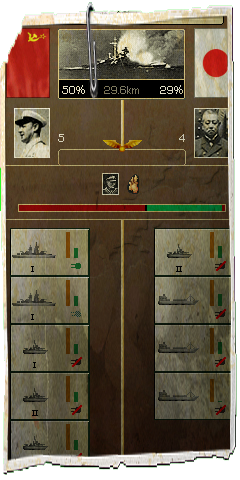
Kuznetsov facing a minor Japanese fleet in the Gulf of Finland, on June 4.
Kuznetsov determined that he had to be aggressive, and followed the fleeing Japanese ships into the Gulf of Riga. There he found even more transports, another seven transport divisions! Presuming that they were all full of troops, as he could not rationally assume otherwise, he immediately went onto the attack to attempt to blast them. After all, they could be landing a force of up to ten divisions in the Baltic Soviet Socialist Republics, and he knew that the Baltic Fronts were not capable of repelling such an assault without giving a lot of ground first—they simply did not have the commanders capable of commanding large formations of troops.
The Japanese escaped again after four hours, but Kuznetsov was able to entirely savage one of their transport divisions, sinking all its ships and consigning a likely division’s worth of combat troops to the depths of the ocean. Their remaining ships fled back into the Gulf of Finland.
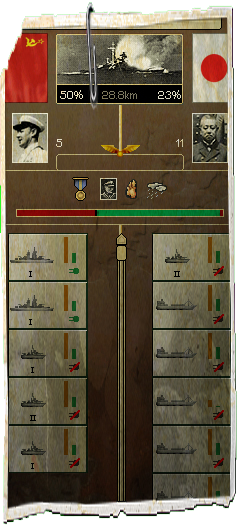
The battle in the Gulf of Riga on June 5, which resulted in one completely destroyed transport division and a likely corresponding loss of combat troops.
Kuznetsov continued chasing them, worrying about the Japanese armada he knew had to be around somewhere. Nevertheless, he believed that sacrificing his fleet to destroy the transports was a fair trade and a worthy end, if it came to that. Until then, he knew that he would simply act the part of the metaphorical wolf amongst the sheep. Back in the Gulf of Finland, the gunfire of his battleship and battlecruiser sank the last of the Japanese destroyers, ending that minor threat and leaving him the sole armed fleet in the Baltic as far as he was concretely aware.
He had to fruitlessly chase them back into the Gulf of Riga and then again back into the Gulf of Finland again, cornering them and sinking another transport division. They fled back into the Gulf of Riga and Kuznetsov again followed them, by then wondering what sort of twisted game they were playing. By the 11th, however, the Japanese had made their game clear when they managed to defeat the Narva garrison in a third attempt on the 8th and then land at Tallinn and Pärnu early in the morning on the 11th.
The Japanese were down to six transport division, two of them slightly damaged and one nearly destroyed, but they had unfortunately managed to get four divisions ashore. Despite his general successes in minor sinkings and in keeping the Japanese on the run, they had somehow managed to land and seize control of what represented more than one half of the geographical area of the Estonian Socialist Soviet Republic.
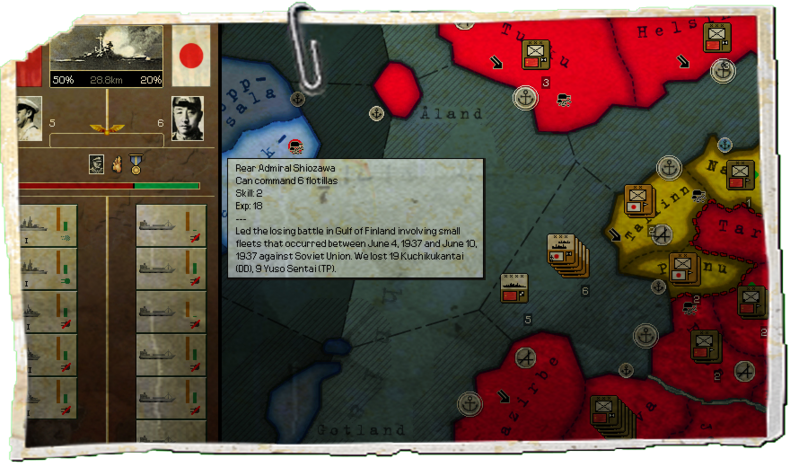
Kuznetsov still attacking Japanese transport shipping in the Baltic even as Japanese troops overrun Estonia.
What Kuznetsov was wondering, of course, was what strategic plan the Japanese had. Given their targets, he thought that perhaps they were aiming at triggering spontaneous nationalist uprisings not only in Estonia but Latvia and Finland as well, and perhaps even further afield in Belarus and the Ukraine—even Turkey. But first they had to disgrace Soviet arms in Estonia, and they had already somewhat disgraced Kuznetsov’s Baltic Fleet. They had not sunk his ships or even damaged any of them, but they had landed four entire divisions despite his best efforts. Kuznetsov knew Stalin would not be pleased, but perhaps he could be mollified if Kuznetsov offered naval gunnery in a fire support role for the coming campaign to eject the Japanese.
June 11, 1937
Kuznetsov leaned back in the chair in his office, pushing up against the floor until the chair was tilted backward against the wall. He would never dare sit like that with any underlings around but he was alone, and thus assumed his favored position of sitting despite its blatant informality. He found that he came up with his best ideas when he sat in what were apparently counter-revolutionary positions, for their sheer dangerous and nonconformist nature served as a sort of conduit for his thoughts and allowed them to break out of the box. And for the strategic problem he was contemplating, he needed all the brilliancy he could muster, for he was review the events of the past slightly more than a week.
It was eight days ago that the Japanese gained complete strategic surprise over the Soviet Union by attacking Narva. That battle had been won in slightly more than a day of battle, but the Japanese transports had remained at large in the Baltic, presumably with considerable portions of the Japanese main battle fleet in tow to provide escort and wreak havoc in their own way. However, Kuznetsov had known that he could now allow the Japanese to frolic so freely in the Soviet Union’s own pond—or one of them, at least. Thus, he had sallied forth as quickly as he could, risking Stalin’s displeasure due to his burst of independent initiative and the danger of the Japanese battle fleet, to strike at the transports.
What he found somewhat disturbed him. Specifically, he ran into a small Japanese fleet consisting of three transport divisions and one destroyer division. The Japanese fleet managed to disengage and flee after four hours with no losses, but that did not particularly bother Kuznetsov. What bothered him was that the Japanese main fleet was not in the Gulf of Finland, which meant that it had to be somewhere else—that the Japanese were planning their main invasion to occur elsewhere along the coast!

Kuznetsov facing a minor Japanese fleet in the Gulf of Finland, on June 4.
Kuznetsov determined that he had to be aggressive, and followed the fleeing Japanese ships into the Gulf of Riga. There he found even more transports, another seven transport divisions! Presuming that they were all full of troops, as he could not rationally assume otherwise, he immediately went onto the attack to attempt to blast them. After all, they could be landing a force of up to ten divisions in the Baltic Soviet Socialist Republics, and he knew that the Baltic Fronts were not capable of repelling such an assault without giving a lot of ground first—they simply did not have the commanders capable of commanding large formations of troops.
The Japanese escaped again after four hours, but Kuznetsov was able to entirely savage one of their transport divisions, sinking all its ships and consigning a likely division’s worth of combat troops to the depths of the ocean. Their remaining ships fled back into the Gulf of Finland.

The battle in the Gulf of Riga on June 5, which resulted in one completely destroyed transport division and a likely corresponding loss of combat troops.
Kuznetsov continued chasing them, worrying about the Japanese armada he knew had to be around somewhere. Nevertheless, he believed that sacrificing his fleet to destroy the transports was a fair trade and a worthy end, if it came to that. Until then, he knew that he would simply act the part of the metaphorical wolf amongst the sheep. Back in the Gulf of Finland, the gunfire of his battleship and battlecruiser sank the last of the Japanese destroyers, ending that minor threat and leaving him the sole armed fleet in the Baltic as far as he was concretely aware.
He had to fruitlessly chase them back into the Gulf of Riga and then again back into the Gulf of Finland again, cornering them and sinking another transport division. They fled back into the Gulf of Riga and Kuznetsov again followed them, by then wondering what sort of twisted game they were playing. By the 11th, however, the Japanese had made their game clear when they managed to defeat the Narva garrison in a third attempt on the 8th and then land at Tallinn and Pärnu early in the morning on the 11th.
The Japanese were down to six transport division, two of them slightly damaged and one nearly destroyed, but they had unfortunately managed to get four divisions ashore. Despite his general successes in minor sinkings and in keeping the Japanese on the run, they had somehow managed to land and seize control of what represented more than one half of the geographical area of the Estonian Socialist Soviet Republic.

Kuznetsov still attacking Japanese transport shipping in the Baltic even as Japanese troops overrun Estonia.
What Kuznetsov was wondering, of course, was what strategic plan the Japanese had. Given their targets, he thought that perhaps they were aiming at triggering spontaneous nationalist uprisings not only in Estonia but Latvia and Finland as well, and perhaps even further afield in Belarus and the Ukraine—even Turkey. But first they had to disgrace Soviet arms in Estonia, and they had already somewhat disgraced Kuznetsov’s Baltic Fleet. They had not sunk his ships or even damaged any of them, but they had landed four entire divisions despite his best efforts. Kuznetsov knew Stalin would not be pleased, but perhaps he could be mollified if Kuznetsov offered naval gunnery in a fire support role for the coming campaign to eject the Japanese.
I'd sat that could have been worse. There could be more Japs landing had you not engaged the fleet. They don't appear to have any reinforcements either so mopping them up hopefully won't be too much problem. Irritating but not really that harmful, it seems.
The Japs are up to six total divisions now in Estonia? I suppose that now constitutes a tide.  Always fun to chase transport fleets around.
Always fun to chase transport fleets around.
i think the soviet union sinking any japanese ship in the early years constitutes a victory, considering the rather... unbalanced naval strength of the two.
I'm not sure which is worse: the fact that the Japanese sent a virtually unescorted transport fleet around the world on a crack-brained scheme or the fact that the Red Navy can't sink said fleet. Though at elast the Soviet's have the excuse of using what I can only assume are sail-powered vessels.
coz1: Yep, that's a pretty good overview of the situation. Damn irritating Japs making strange, strange strategic decisions 
grayghost: Yes, yes, very fun...bastards are harder to catch than greased pigs
BritishImperial: Well, it seems to be pretty imbalanced in my favor at the moment
VILenin: Yes, actually the 'Red' part of the 'Red Baltic Fleet' refers to the color of their sails and hulls rather than to the fact that they're the naval arm of the Soviet Union
First comment day!
grayghost: Yes, yes, very fun...bastards are harder to catch than greased pigs
BritishImperial: Well, it seems to be pretty imbalanced in my favor at the moment
VILenin: Yes, actually the 'Red' part of the 'Red Baltic Fleet' refers to the color of their sails and hulls rather than to the fact that they're the naval arm of the Soviet Union
First comment day!
Oh, I thought red referred to the color of their sails and hulls only in so far as they are stained with the blood of the fish that they use those boats to catch.
Discomb: I don't see where what I said and what you said conflict in any way 
ColossusCrusher: Maybe...and hey CC, haven't seen ya 'round in a while, good to have you posting a bit again
Second comment day
ColossusCrusher: Maybe...and hey CC, haven't seen ya 'round in a while, good to have you posting a bit again
Second comment day
Clearly the Japanese are taking avenge for the Khalkin-Gol that I can't remember really happening in this timeline, or did it?  Im confused. :wacko:
Im confused. :wacko:
This is pretty off-topic, but I just realized that if bring Spain into the Comintern then their navy would be the Red ships of Spain! My apologies to everyone who doesn't get the reference - you'll just have to take my word that it's hilarious. 
General Jac: In OTL, Khalkin-Gol would occur in two years, but it won't happen in this alternate timeline. So think about this, Japan is waging a preventive war against the Soviet Union so that Khalkin-Gol won't happen, and it won't anyway! Ye gods, the Japanese must be strategic geniuses! Or strategic nincompoops, depending on how much you analyze it. 
ColossusCrusher: It's good that you hadn't just disappeared in a poof of magic, of dust, of math homework, whatever, that's typically a bad sign of evil intention somewhere along the line. Plus, I've missed seeing your avatar and reading your posts
VILenin: All right, word taken
Update coming up!
ColossusCrusher: It's good that you hadn't just disappeared in a poof of magic, of dust, of math homework, whatever, that's typically a bad sign of evil intention somewhere along the line. Plus, I've missed seeing your avatar and reading your posts
VILenin: All right, word taken
Update coming up!
7 kilometers north of Riga
June 18, 1927
The Soviets reacted quickly to the new Japanese threat, or as quickly as the military bureaucracy would allow. Berzarin was only a lowly Lieutenant General, though apparently he was slated to become a full Colonel-General, if not a Field Marshal, if the unofficial grapevine was to be believed. How the grape vine managed to reach all the way from STAVKA’s secret plans and schemes to southern Latvia, Berzarin did not know. But he did know that apparently he was to be the commander of the 1st Baltic Front. By sheer coincidence, that was actually what he was at the moment. De facto, anyway, even if not yet de jure, for the Japanese inroads into Estonia was quite embarrassing to the Soviet Union’s reputation both domestically and internationally, even more than its defeats in Manchuria were for those could be explained away through a variety of excuses.
The Japanese presence in Estonia could not be simply explained away. Well, it could, Berzarin knew: STAVKA was a rational entity, the Japanese Imperial General Staff apparently were not. Berzarin, looking at the issue from his own limited viewpoint, could not understand what they were doing. Surely they must have been aware of Imperial Russia’s grand mistake in the war of 1904-1905 when it sent the Baltic Fleet all the way around the globe of the earth to sink in Tsushima Strait. Now, it seemed, the Japanese were repaying the favor by sending their fleet, or weak parts of it, to the Baltic to be sunk. Though at least they were having the success of landing troops and embarrassing the Soviet Union, which is something Imperial Russia had not been able to do. It had embarrassed no one but itself, and perhaps the Japanese, Berzarin had well in mind the stereotype of the polite Japanese samurai, embarrassed that he had won by lowly ambush.
This, of course, was a strategic ambush, an insane strategic ambush. Berzarin wondered whether insanity came with the notions and ambitions of imperialism. However, he soon turned his mind to the task at hand, reviewing the events of the past week so that he may write a condensed report for STAVKA. Early on the 13th, two days after the Japanese had managed their coup at Pärnu and Tallinn, the Japanese attacked Tartu. Their four infantry divisions, commanded by the aggressive Lieutenant General Ishiwara, quickly brushed aside the two motorized rifle divisions that comprised the reserve of one Baltic Front or another. The paperwork was so shoddy that Berzarin wasn’t actually sure to which Front they belonged. Nevertheless, they put up a small fight before being defeated and thrown back into Latvia. At the same time, Berzarin was ordered to take command of the entire 1st Baltic Front, of which previously he had only commanded the 21st Rifle Corps, which was amazingly at full strength at three divisions, much like most of the rest of the Front. Berzarin was actually unsure whether this was good or bad; he had more troops to throw at the Japanese, but that simply meant for work for his drastically overburdened staff.
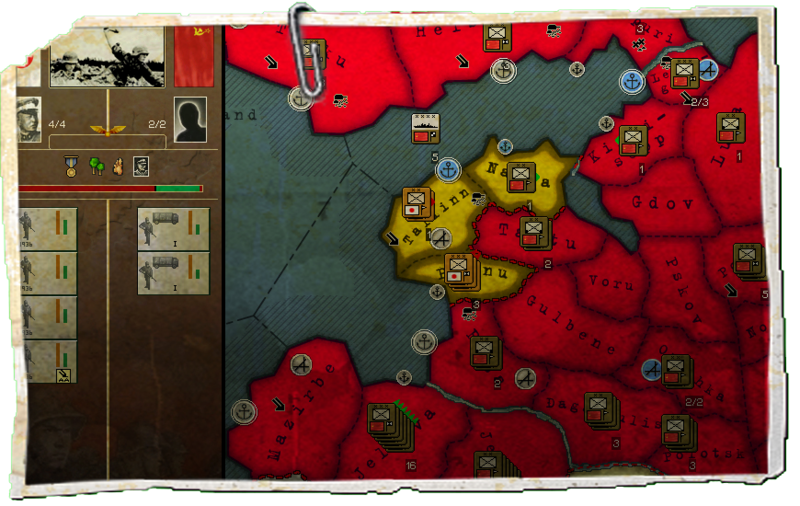
The first battle for Tartu, the Japanese driving from Tallinn and Pärnu toward the interior of the SSR of Estonia.
Late the next day, Berzarin had arrived in Riga with the 1st Baltic Front, joining two motorized rifle divisions that constituted the current reserve of his Front. Biting his lip, Berzarin crinkled his brow before realizing that the motorized rifle divisions at Tartu must have belonged to the 2nd Baltic Front. He shrugged. Sighing, he shuffled his papers until he came upon the report of the battle that ensued after his arrival in Riga, as he pushed toward Pärnu against four divisions, commanded by the same Ishiwara that had assaulted Tartu. The outcome was, of course, not in much doubt. Four divisions of troops, no matter how insane or fanatical, could not resist more than four times their number, even if they were in actuality poorly led. The sheer crush of men advancing from one direction overwhelmed the Japanese defenses fairly quickly.
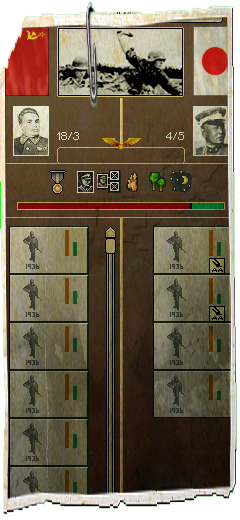
The greatly overcrowded battle for Pärnu.
At the same time, a Soviet division from the Leningrad Front had advanced back into Narva and been defeated by Japanese soldiers advancing from Tallinn commanded by a Major General Suzuki Shigeyasu. However, that one leaderless Soviet division managed to accomplish something quite unexpected, strangely amusing and honestly downright odd. The troops managed to capture a transport ship belonging to the 19 Yuso Sentai transport division, which was part of the 23. Kaigan, that was harboring in the mouth of the Narva River at the time, hiding from Kuznetsov’s fleet. Stalin made sure to announce the great victory, showing that he had a sense of humor, and greatly embarrassing the Japanese government in the process.
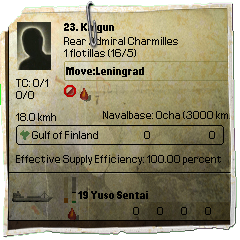
The captured Japanese transport, being commanded by a strange person who claimed to be a Soviet Frenchman, Claude Charmilles. The logs of the transport ship showed that its home base was in Ocha.
The transport was captured on the 16th, and it was essentially two days later that the campaign was decided. Both Pärnu and Tallinn had fallen, Narva had not been recaptured by the Japanese and while three divisions fled from Pärnu into surrender at Tallinn, one final Japanese division was trapped at Tartu under the command of a Major General Inagaki. It was trapped, out of supply and under attack by the two motorized rifle divisions of the reserve of the 1st Baltic Front. The Japanese were quickly defeated.
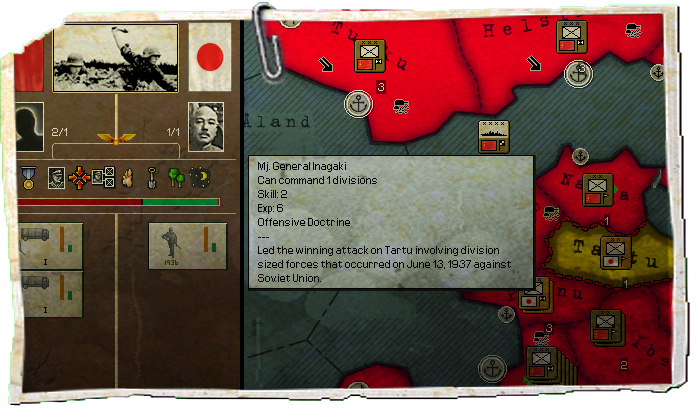
The second battle for Tartu. The campaign for Estonia began and ended at that town.
Berzarin rolled his head back and took a deep breath before expelling it out in a gusty, if a bit weary, sigh. The Estonian campaign was the first test of his operational skill, and he assumed that he passed it. Despite his slightly inelegant methods, he knew his staff was overworked and could not manage anything better and STAVKA wanted a quick victory. He gave them that, having effectively crushed the Japanese threat in Estonia in a week. Berzarin smiled, perhaps he would become a Field Marshal after all.
June 18, 1927
The Soviets reacted quickly to the new Japanese threat, or as quickly as the military bureaucracy would allow. Berzarin was only a lowly Lieutenant General, though apparently he was slated to become a full Colonel-General, if not a Field Marshal, if the unofficial grapevine was to be believed. How the grape vine managed to reach all the way from STAVKA’s secret plans and schemes to southern Latvia, Berzarin did not know. But he did know that apparently he was to be the commander of the 1st Baltic Front. By sheer coincidence, that was actually what he was at the moment. De facto, anyway, even if not yet de jure, for the Japanese inroads into Estonia was quite embarrassing to the Soviet Union’s reputation both domestically and internationally, even more than its defeats in Manchuria were for those could be explained away through a variety of excuses.
The Japanese presence in Estonia could not be simply explained away. Well, it could, Berzarin knew: STAVKA was a rational entity, the Japanese Imperial General Staff apparently were not. Berzarin, looking at the issue from his own limited viewpoint, could not understand what they were doing. Surely they must have been aware of Imperial Russia’s grand mistake in the war of 1904-1905 when it sent the Baltic Fleet all the way around the globe of the earth to sink in Tsushima Strait. Now, it seemed, the Japanese were repaying the favor by sending their fleet, or weak parts of it, to the Baltic to be sunk. Though at least they were having the success of landing troops and embarrassing the Soviet Union, which is something Imperial Russia had not been able to do. It had embarrassed no one but itself, and perhaps the Japanese, Berzarin had well in mind the stereotype of the polite Japanese samurai, embarrassed that he had won by lowly ambush.
This, of course, was a strategic ambush, an insane strategic ambush. Berzarin wondered whether insanity came with the notions and ambitions of imperialism. However, he soon turned his mind to the task at hand, reviewing the events of the past week so that he may write a condensed report for STAVKA. Early on the 13th, two days after the Japanese had managed their coup at Pärnu and Tallinn, the Japanese attacked Tartu. Their four infantry divisions, commanded by the aggressive Lieutenant General Ishiwara, quickly brushed aside the two motorized rifle divisions that comprised the reserve of one Baltic Front or another. The paperwork was so shoddy that Berzarin wasn’t actually sure to which Front they belonged. Nevertheless, they put up a small fight before being defeated and thrown back into Latvia. At the same time, Berzarin was ordered to take command of the entire 1st Baltic Front, of which previously he had only commanded the 21st Rifle Corps, which was amazingly at full strength at three divisions, much like most of the rest of the Front. Berzarin was actually unsure whether this was good or bad; he had more troops to throw at the Japanese, but that simply meant for work for his drastically overburdened staff.

The first battle for Tartu, the Japanese driving from Tallinn and Pärnu toward the interior of the SSR of Estonia.
Late the next day, Berzarin had arrived in Riga with the 1st Baltic Front, joining two motorized rifle divisions that constituted the current reserve of his Front. Biting his lip, Berzarin crinkled his brow before realizing that the motorized rifle divisions at Tartu must have belonged to the 2nd Baltic Front. He shrugged. Sighing, he shuffled his papers until he came upon the report of the battle that ensued after his arrival in Riga, as he pushed toward Pärnu against four divisions, commanded by the same Ishiwara that had assaulted Tartu. The outcome was, of course, not in much doubt. Four divisions of troops, no matter how insane or fanatical, could not resist more than four times their number, even if they were in actuality poorly led. The sheer crush of men advancing from one direction overwhelmed the Japanese defenses fairly quickly.

The greatly overcrowded battle for Pärnu.
At the same time, a Soviet division from the Leningrad Front had advanced back into Narva and been defeated by Japanese soldiers advancing from Tallinn commanded by a Major General Suzuki Shigeyasu. However, that one leaderless Soviet division managed to accomplish something quite unexpected, strangely amusing and honestly downright odd. The troops managed to capture a transport ship belonging to the 19 Yuso Sentai transport division, which was part of the 23. Kaigan, that was harboring in the mouth of the Narva River at the time, hiding from Kuznetsov’s fleet. Stalin made sure to announce the great victory, showing that he had a sense of humor, and greatly embarrassing the Japanese government in the process.

The captured Japanese transport, being commanded by a strange person who claimed to be a Soviet Frenchman, Claude Charmilles. The logs of the transport ship showed that its home base was in Ocha.
The transport was captured on the 16th, and it was essentially two days later that the campaign was decided. Both Pärnu and Tallinn had fallen, Narva had not been recaptured by the Japanese and while three divisions fled from Pärnu into surrender at Tallinn, one final Japanese division was trapped at Tartu under the command of a Major General Inagaki. It was trapped, out of supply and under attack by the two motorized rifle divisions of the reserve of the 1st Baltic Front. The Japanese were quickly defeated.

The second battle for Tartu. The campaign for Estonia began and ended at that town.
Berzarin rolled his head back and took a deep breath before expelling it out in a gusty, if a bit weary, sigh. The Estonian campaign was the first test of his operational skill, and he assumed that he passed it. Despite his slightly inelegant methods, he knew his staff was overworked and could not manage anything better and STAVKA wanted a quick victory. He gave them that, having effectively crushed the Japanese threat in Estonia in a week. Berzarin smiled, perhaps he would become a Field Marshal after all.
It's a side show, really. But one that will earn Berzarin his stripes. Maybe send him over to Manchuria and see what he can do. 
thank god, i was getting worried there that the stability of the whole union was at risk
by the way, the date says 1927,which i assume is wrong unless... no i assume its wrong
by the way, the date says 1927,which i assume is wrong unless... no i assume its wrong
Well that was odd.
That's nice, that you care about my slightly...odd view of things.
That's nice, that you care about my slightly...odd view of things.
An 18/3 command ratio in that battle! Your generals are in some dire need of promotions. Now that the Estonian front has been locked up, what next? I'm hoping for a sneak invasion of Japan. 

